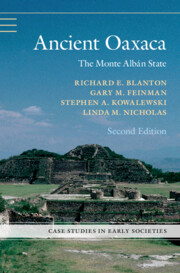Book contents
- Ancient Oaxaca
- Case Studies in Early Societies
- Ancient Oaxaca
- Copyright page
- Contents
- Figures
- Preface to the Second Edition
- 1 Introduction: Mesoamerica and Its Pre-Hispanic Civilization
- 2 Theorizing Sociocultural Evolution
- 3 Before Monte Albán
- 4 Origins of Monte Albán
- 5 The Great Transformation
- 6 Thinking About Theories of Sociocultural Evolution from the Perspective of Oaxaca
- 7 Cooperation and the Foundation of Monte Albán
- Epilogue
- Bibliographical Essay
- Bibliography
- Index
2 - Theorizing Sociocultural Evolution
Published online by Cambridge University Press: 07 July 2022
- Ancient Oaxaca
- Case Studies in Early Societies
- Ancient Oaxaca
- Copyright page
- Contents
- Figures
- Preface to the Second Edition
- 1 Introduction: Mesoamerica and Its Pre-Hispanic Civilization
- 2 Theorizing Sociocultural Evolution
- 3 Before Monte Albán
- 4 Origins of Monte Albán
- 5 The Great Transformation
- 6 Thinking About Theories of Sociocultural Evolution from the Perspective of Oaxaca
- 7 Cooperation and the Foundation of Monte Albán
- Epilogue
- Bibliographical Essay
- Bibliography
- Index
Summary
With its rich archaeological data from surveys and excavations, Monte Albán and its regional context in highland Oaxaca, along with cross-cultural comparative science, are useful for evaluating current theories about sociocultural evolution. Older theories and persistent ideas about only two paths to state building – premodern (Oriental) and modern democratic (Occidental) – are less effective as explanations than those that recognize alternative pathways, heterarchy, and multiple important institutions. Collective action theory shows significant promise.
- Type
- Chapter
- Information
- Ancient OaxacaThe Monte Albán State, pp. 21 - 41Publisher: Cambridge University PressPrint publication year: 2022

